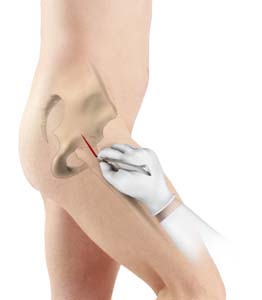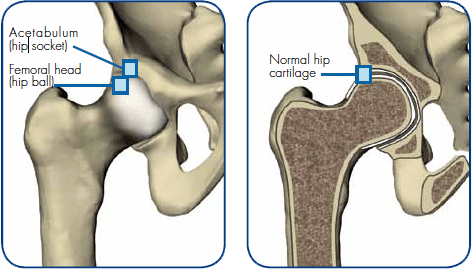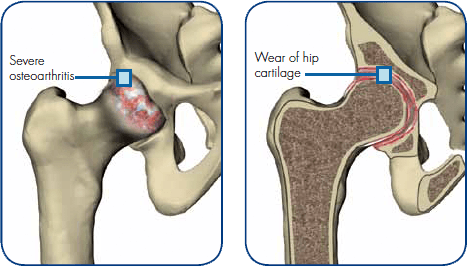Minimally Invasive Revision THR - Anterior Approach

Introduction
The hip joint is the articulation of the axial skeleton with the lower limb. As we use our hips for walking, rotating and flexing the lower limb, they are subjected to loads during almost all movements. It is not surprising that the hip joint is liable to injury or development of degenerative joint diseases, such as osteoarthritis.
One of the consequences of any joint disease is pain.
Hip pain limits your daily activities, affects your mood, your health and, definitely, your general wellbeing.
There are a number of solutions, surgical and non-surgical, to treat your disease. Ask your doctor what is the most suitable treatment for your age, activity level and expectations. In the case of advanced osteoarthritis, hip pain and stiffness severely limit your life and your doctor may suggest that you undergo a total hip replacement.
The Hip and Osteoarthritis
Anatomy of the Hip Joint
The hip joint is formed by the articulation of the rounded head of the femur and the cup-like acetabulum of the pelvis. It forms the primary connection between the bones of the lower limb and the axial skeleton of the trunk and pelvis.
The surface of the femoral head and the acetabulum, where the bones come into contact, is coated with a smooth tissue called articular cartilage. The cartilage, together with a substance called synovial fluid, prevents the bones from rubbing against each other and from becoming damaged.
Osteoarthritis of the Hip
The main cause of hip joint diseases is the wear of the articular cartilage: osteoarthritis. This wear is perceived as pain, initially only when a load is bearing on the joint, then more and more frequently, and finally also at rest.
The increase in intensity of the pain is a slow process, sometimes over many years, and can lead to a stiff hip joint. Hip replacement is a common treatment for severe osteoarthritis. Successful hip replacement brings dramatic pain relief and improvement in the function of the hip joint.


Total Hip Replacement
What is Total Hip Replacement?
Total hip replacement surgery substitutes the damaged bone and cartilage of the joint with polyethylene (a plastic material) or ceramic and metallic components. A hip prosthesis is an artificial articulation, composed of a femoral stem with a head (sphere) and a socket cup (acetabular shell and liner, if any). The femoral stem is made of metal (usually a Titanium or Cobalt Chrome alloy or stainless steel). The head is made of ceramic or metal. The cup is made of 1 or 2 pieces, depending on the procedure: cemented (usually only one component of polyethylene) or cementless (metallic acetabular shell and liner). In the case of metallic acetabular shell, a ceramic or polyethylene liner articulates against the head. All the materials used for hip arthroplasty are highly biocompatible.
Why Total Hip Replacement
With almost 70 years of history, total hip replacement surgery is a very common and safe procedure for the treatment of severe arthritis. The main benefits of a successful total hip replacement are:
- Reduction in hip pain
- The pain will be rapidly and dramatically reduced and usually eliminated.
- Recovery of mobility
- Your hip will function with less effort, almost regaining its original mobility.
- Improvement in quality of life
- Your everyday activities and your social life will no longer be limited by pain and reduced mobility.
AMIS and Conventional Approaches
What is Minimally Invasive Surgery?
The surgeon can access the hip joint by different paths, following a "conventional" surgical approach or a Minimally Invasive Surgical approach (MIS). True Minimally Invasive Surgery is characterised by the preservation of muscles and tendons encountered during the surgery to the hip joint capsule and offers a reduced skin incision.
AMIS® is true Minimally Invasive Surgery. Other approaches advertised as minimally invasive (posterior, lateral or double incision) are only reduced skin incision techniques and are associated with the same muscle and/ or tendon injury as "conventional" approaches.
AMIS® does not cut muscles and does respect nerves.
In fact, the anterior approach is the only technique which follows inter-muscular and internervous planes to reduce the risk of injury to muscles, tendons, vessels and nerves. Possible muscular release is reduced to a minimum and in all cases is less significant than with other surgical approaches.
For this reason, AMIS® is the ideal approach for atraumatic surgery which is fundamental for a fast recovery: AMIS® will improve the quality of your life and hasten your recovery after a Total Hip Replacement.
The AMIS® technique has decreased the incidence of complications when compared to "conventional" techniques. Your doctor will assist in providing more details.
Why an AMIS Total Hip Replacement?
The AMIS® technique causes less surgical trauma than other techniques because no muscles are cut, which aids in rapid recovery
AMIS® can potentially provide you with the following benefits:
- Decreased post-operative pain In comparison with "conventional" surgical techniques, the AMIS® approach can reduce the postoperative pain as muscles are not cut.
- Shorter rehabilitation Rehabilitation can usually start the day of the operation, or the day after, subject to your doctor's approval, based on your post-operative conditions. Standing up and walking with arm crutches can start immediately, with your doctor's authorisation.
- Shorter hospital stay The AMIS® technique usually significantly reduces the duration of hospital stay. Your surgeon may still recommend a longer stay, depending on your post-operative condition.
- Small skin scar With AMIS®, the skin incision is often shorter than with "conventional" surgery and therefore scar tissue is reduced.
- Faster return to daily activities The AMIS® technique allows you to return to daily activities in a shorter time frame.
- Less blood loss Preservation of muscles and vessels potentially reduces blood loss. Transfusions are rare and blood clots in the legs (deep venous thromboses) are less likely.
- Reduced risk of dislocation As a result of the AMIS® technique the preservation of muscles significantly improves the stability of the hip. The risk of dislocation is minimal and the post-operative limitation of movements, usually prescribed in other techniques, is not necessary. The risk of dislocation is reduced because the anterior approach is performed from the front of your body and dislocation is mainly related to posterior hip structure damage.
- Prevention of limping AMIS® is characterised by a surgical technique that protects the various muscles, blood vessels and nerves encountered during exposure of the hip joint. Minimising muscle and nerve damage reduces the chances of limping.
You may drive when able to get in and out of the car comfortably, have excellent control of your legs and are not taking pain medications.
Depending on your general condition and only with approval from your surgeon, you may be driving in 8 -10 days .
Goal of AMIS®
The primary goal of AMIS® Total Hip Replacement is to minimise harm to muscles, blood vessels and nerves surrounding the joint. The AMIS® technique is the specifically designed method to achieve this goal.
Getting Ready for Your Operation
Tests & Checks
Before undergoing your total hip replacement, your doctor will prescribe a complete physical examination to assess your condition and to ensure that there are no factors that could interfere with your surgery.
Test
Your doctor may ask you for blood and urine tests and possibly a cardiogram, prior to your surgery.
Test Yourself
1. Check your Skin
If your hip and leg have any skin infections or irritation, contact your orthopaedic surgeon prior to surgery: he or she will tell you how best to prepare your skin for surgery.
2. Check your Teeth
The incidence of infection after hip replacement is very low, but even an infection far from the hip joint can spread through the bloodstream to the new hip. Prevention is the best way to avoid early problems. Therefore, you should contact your dentist to have your teeth checked before your total hip replacement surgery.
Medication
Prior to surgery, provide your surgeon with a complete list of the medications you are taking including doses and times. He or she will inform you if you need to stop or change any medication.
Special Equipment
After the intervention special equipment, such as support stockings and crutches, may be needed: you can rent or buy them from specialised shops. Check with your physiotherapist.
In the Hospital
Take with You
- A complete list of your routine medications including doses and times; your x-rays
- All papers for hospital admission including a copy of insurance cards (if requested in your country)
- Any equipment (crutches, stockings, etc.) ordered for you by your doctor
The Day of your Operation
The surgical procedure will take about 1 to 2 hours.
It will be preceded by pre-surgical preparation and followed by monitoring in the recovery room.
The time away from your room will be longer than the operation due to time needed for your preparation for surgery, administration of anaesthesia and monitoring as you recover from the anaesthetic. Special care is taken to relieve pain after the surgery. Do not hesitate to call, even in the middle of the night, to obtain relief. Regular checks will be made by the nurses.
After the Operation
Specialised personnel will, from day one after the surgery, take care of your recovery by defining the most suitable rehabilitation program for you and accompanying you through the gradual recovery process.
Rehabilitation can be started the day of the operation, subject to your doctor's approval. You may progress to weight bearing activities as tolerated and may discontinue assistive devices as your comfort level improves. Although patients may be quite variable, most discontinue assistive devices within two weeks post-operatively.
Taking Care of your New Hip
Long-term Care of your Total Hip
Follow your orthopaedic surgeon's instructions carefully to minimise any potential complications which can affect your recovery and your implant lifetime. These complications, however, are quite infrequent and some simple rules can dramatically reduce their likelihood.
Don't Forget
- Lead a healthy and active life
- In case of fever, throat inflammation or any infection, tell your doctor that you have a hip implant
- Undergo regular general check-ups
